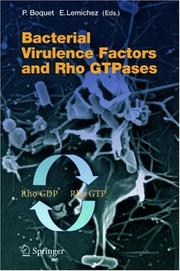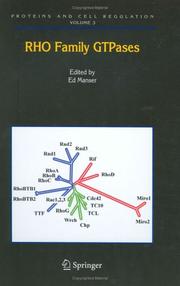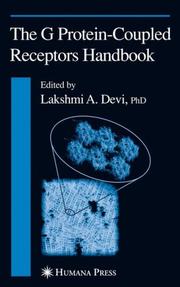| Listing 1 - 10 of 25 | << page >> |
Sort by
|
Book
ISBN: 9782889196463 Year: 2015 Publisher: Frontiers Media SA
Abstract | Keywords | Export | Availability | Bookmark
 Loading...
Loading...Choose an application
- Reference Manager
- EndNote
- RefWorks (Direct export to RefWorks)
Cyclic nucleotides control a number of neuronal properties including neuronal differentiation, pathfinding, regulation of excitability and synaptic transmission, and control of gene expression. Signaling events mediated by cAMP or cGMP are transient and take place within the complex 3-dimensional structure of the neuronal cell. Signaling events happen on the time scale of seconds to minutes and the biological significance of the temporal dimension remains poorly understood. Structural features of neurons (dendritic spines and branches, cell body, nucleus, axon…) as well as AKAPs and other scaffolding proteins that keep signaling enzymes together and form "signaling microdomains", are critical spatial determinants of signal integration. Finally, the types of enzymes involved in signal integration, which are expressed as a number of different types and splice variants, yield another dimension that determines signal integration properties. Biosensor imaging provides direct temporal and spatial measurement of intracellular signals. This novel approach, together with more conventional methods such as biochemistry, electrophysiology, and modeling, now provide a better understanding of the spatial and temporal features of cyclic nucleotide signal integration in living neurons. This topic aims at providing a better understanding of how neurons are "making sense" of cyclic nucleotide signaling in living neurons.
Neurons --- Nerve cells --- Neurocytes --- Cells --- Nervous system --- rac GTP-Binding Proteins --- Dopamine --- biosensor imaging --- compartmentalization --- noradrenalin --- Cyclic GMP --- Cyclic AMP --- phosphodiesterases --- Endocannabinoids
Book
ISBN: 0128197714 0128197722 9780128197721 9780128197714 Year: 2022 Publisher: London, England : Academic Press,
Abstract | Keywords | Export | Availability | Bookmark
 Loading...
Loading...Choose an application
- Reference Manager
- EndNote
- RefWorks (Direct export to RefWorks)
"Allosteric Modulation of G Protein-Coupled Receptors reviews fundamental information on G protein-coupled receptors (GPCRs) and allosteric modulation, presenting original research in the area and collectively providing a comprehensive description of key issues in GPCR allosteric modulation. The book provides background on core concepts of molecular pharmacology while also introducing the most important advances and studies in the area. It also discusses key methodologies."--
Allosteric regulation. --- Allosteric mechanisms --- Allosteric modulation --- Allosterism --- Mechanisms, Allosteric --- Modulation, Allosteric --- Regulation, Allosteric --- Biological control systems --- G proteins --- GTP-Binding Proteins --- Allosteric Regulation --- Receptors.
Book
ISBN: 1441911103 144191112X 9786612831768 1441911111 1282831763 1489982868 Year: 2010 Publisher: New York : Springer,
Abstract | Keywords | Export | Availability | Bookmark
 Loading...
Loading...Choose an application
- Reference Manager
- EndNote
- RefWorks (Direct export to RefWorks)
The Rho GTPases in Cancer is the first volume to collect and summarize the current understanding of the Rho GTPases and their involvement in the progression of human cancer. The critical role of the Rho GTPases, their regulatory proteins, and their effectors in cancer progression has become increasingly evident over the past decade. As translational research increases on these proteins, their importance as keystone molecules in vital cellular process is highlighted. Thus, these molecules represent a major class of potential therapeutic targets that could be exploited clinically. This aspect of Rho GTPase biology is developing, therefore the contents of The Rho GTPases in Cancer should prove of interest to clinicians and members of the cancer research community wishing to develop new treatments for cancer.
Cancer -- Etiology. --- Rho GTPases --- Cancer --- Monomeric GTP-Binding Proteins --- Diseases --- rho GTP-Binding Proteins --- Neoplasms --- GTP-Binding Proteins --- Intracellular Signaling Peptides and Proteins --- GTP Phosphohydrolases --- Peptides --- Proteins --- Carrier Proteins --- Amino Acids, Peptides, and Proteins --- Acid Anhydride Hydrolases --- Chemicals and Drugs --- Hydrolases --- Enzymes --- Enzymes and Coenzymes --- Medicine --- Human Anatomy & Physiology --- Oncology --- Animal Biochemistry --- Health & Biological Sciences --- Etiology --- Rho GTPases. --- G proteins. --- GTP-binding proteins --- GTP regulatory proteins --- Guanine nucleotide-binding proteins --- Guanine nucleotide regulatory proteins --- Rho G proteins --- Rho GTP-binding proteins --- Medicine. --- Cancer research. --- Pharmacology. --- Cell biology. --- Biomedicine. --- Cancer Research. --- Cell Biology. --- Pharmacology/Toxicology. --- Membrane proteins --- G proteins --- Guanosine triphosphatase --- Oncology. --- Cytology. --- Toxicology. --- Chemicals --- Pharmacology --- Poisoning --- Poisons --- Cell biology --- Cellular biology --- Biology --- Cells --- Cytologists --- Tumors --- Toxicology --- Drug effects --- Medical pharmacology --- Medical sciences --- Chemotherapy --- Drugs --- Pharmacy --- Cancer research --- Physiological effect

ISBN: 1280306319 9786610306312 3540275118 3540238654 3642062806 Year: 2005 Publisher: Berlin ; [Great Britian] : Springer,
Abstract | Keywords | Export | Availability | Bookmark
 Loading...
Loading...Choose an application
- Reference Manager
- EndNote
- RefWorks (Direct export to RefWorks)
Pathogenic bacteria for human and animals have developed sophisticated weapons, termed virulence factors, to ensure their replication and persistence into their hosts. The first role of these virulence factors is to loosen the host defenses against microorganisms represented by innate and adaptive immunities. Small GTPases of the Rho subfamily have been shown top play important functions in theses systems. The authors of this volume present the synthesis on how the various host cellular Rho GTPases activities are manipulated by bacteria to fulfill their virulence.
Pathogenic bacteria. --- Virulence (Microbiology) --- Rho GTPases. --- Rho G proteins --- Rho GTP-binding proteins --- G proteins --- Guanosine triphosphatase --- Microbial virulence --- Pathogenic microorganisms --- Bacteria, Pathogenic --- Disease germs --- Bacteria --- Bacterial diseases --- Medical bacteriology --- Medical virology. --- Virology. --- Medical microbiology --- Virology --- Virus diseases --- Microbiology
Multi
ISSN: 00711365 17441358 Year: 1965 Publisher: London Academic Press
Abstract | Keywords | Export | Availability | Bookmark
 Loading...
Loading...Choose an application
- Reference Manager
- EndNote
- RefWorks (Direct export to RefWorks)
Biochemistry. --- Chemistry --- Life Sciences --- Biochemistry --- Biology --- General biochemistry --- General biophysics --- Biochimie --- Periodicals --- Périodiques --- MDBIOCHE --- Molecular biology. --- SIGNAL TRANSDUCTION, BIOLOGICAL --- HEAT-SHOCK PROTEINS --- GTP-BINDING PROTEINS --- CELL MEMBRANE --- NITROGEN OXIDE (NO) --- NEUROPEPTIDES --- GROWTH SUBSTANCES --- PLANT CELL --- Biochemie.

ISBN: 1280283823 9786610283828 1402034628 140203461X 9048168732 Year: 2005 Volume: 3 Publisher: Dordrecht ; [Great Britain] : Springer,
Abstract | Keywords | Export | Availability | Bookmark
 Loading...
Loading...Choose an application
- Reference Manager
- EndNote
- RefWorks (Direct export to RefWorks)
Humans contain more than 20 Rho type GTPases. This volume not only presents a detailed phylogenetic analysis of Rho proteins, but also discusses the possible origins of the human members. Such an analysis of human Rho GTPases has not previously been attempted. The book includes an overview of how Rho GTPases become activated which is complemented by an extensive Chapter by Darerca Owen and Helen Mott who unravel the beautiful molecular details given to us by the many structural studies of Rho GTPases. The key areas currently being investigated in relation to these ubiquitous proteins are described for both in vitro and in vivo systems. These are presented in a format that ensures the reader can approach the topic with minimal background knowledge, while ultimately bringing the subject to the level of an expert. Timely and highly authoritative, this volume illuminates newer findings, particularly as they relate to Rho proteins in vertebrate biology.
Rho GTPases. --- G proteins. --- GTP-binding proteins --- GTP regulatory proteins --- Guanine nucleotide-binding proteins --- Guanine nucleotide regulatory proteins --- Membrane proteins --- Rho G proteins --- Rho GTP-binding proteins --- G proteins --- Guanosine triphosphatase --- Cytology. --- Enzymes. --- Biochemistry. --- Proteomics. --- Oncology. --- Medicine. --- Cell Biology. --- Enzymology. --- Biochemistry, general. --- Cancer Research. --- Molecular Medicine. --- Clinical sciences --- Medical profession --- Human biology --- Life sciences --- Medical sciences --- Pathology --- Physicians --- Tumors --- Molecular biology --- Proteins --- Biological chemistry --- Chemical composition of organisms --- Organisms --- Physiological chemistry --- Biology --- Chemistry --- Biocatalysts --- Ferments --- Soluble ferments --- Catalysts --- Enzymology --- Cell biology --- Cellular biology --- Cells --- Cytologists --- Composition --- Health Workforce --- Cell biology. --- Cancer research. --- Molecular biology. --- Molecular biochemistry --- Molecular biophysics --- Biochemistry --- Biophysics --- Biomolecules --- Systems biology --- Cancer research --- Enzymes

ISBN: 1281236381 9786611236380 1592599192 1588293653 1617375225 Year: 2005 Publisher: Totowa, N.J. : Humana Press,
Abstract | Keywords | Export | Availability | Bookmark
 Loading...
Loading...Choose an application
- Reference Manager
- EndNote
- RefWorks (Direct export to RefWorks)
G protein-coupled receptors (GPCRs) are involved in many processes in the human body relevant to health and disease, and consequently are the targets of approximately 70% of pharmacological therapeutics and a major source of new drug candidates. In The G Protein-Coupled Receptors Handbook, leading academic researchers comprehensively survey the many recent advances that have occurred in the GPCR field. The authors describe the current knowledge of GPCR receptor structure and function, the different mechanisms involved in the regulation of GPCR function, and the role of pharmacological chaperones in GPCR folding and maturation. They present new findings about how GPCR dimerization/oligomerization modifies the properties of individual receptors, and show how recent developments are leading to significant advances in drug discovery. They also discuss the most recent developments that could lead to new discoveries: the role of GPCRs in mediating pain, the development of receptor-type selective drugs based on the structural plasticity of receptor activation, and the identification of natural ligands of orphan GPCRs (deorphanization) as possible drug targets. Authoritative and cutting-edge, The G Protein-Coupled Receptors Handbook offers pharmacologists, biochemists, and neuroscientists an exhaustive review of the progress made in understanding how GPCRs are activated and regulated, key factors in exploiting GPCRs for drug development.
G proteins --- Receptors --- Medicine. --- Neurosciences. --- Biomedicine. --- Neural sciences --- Neurological sciences --- Neuroscience --- Medical sciences --- Nervous system --- Clinical sciences --- Medical profession --- Human biology --- Life sciences --- Pathology --- Physicians --- GTP-binding proteins --- GTP regulatory proteins --- Guanine nucleotide-binding proteins --- Guanine nucleotide regulatory proteins --- Membrane proteins
Book
ISBN: 1493912186 1493912178 Year: 2014 Publisher: New York, NY : Springer New York : Imprint: Springer,
Abstract | Keywords | Export | Availability | Bookmark
 Loading...
Loading...Choose an application
- Reference Manager
- EndNote
- RefWorks (Direct export to RefWorks)
We have learned a great deal about the organization and function of GPCR pathways, and the role that they play in vision. The information gained from these studies has provided, and will continue to provide, critical insights to further our understanding of complex GPCR pathways in the central nervous and endocrine systems. In essence, the retina is the first ‘optogenetically’-driven circuit with clearly understood physiology. Thus, studying GPCR-driven pathways in the retina will likely guide the interpretation of optogenetic experiments, which are increasingly utilized to study central circuits. Collectively, these signaling pathways allow the retina to represent visual space over a wide range of light intensities and to synchronize its function to the day/night cycle. G protein Signaling Mechanisms in the Retina summarizes our current understanding of the organizational principles of GPCR pathways, using insights derived from the study of the retina. The book highlights several G protein signaling cascades, including phototransduction, ON bipolar cell signaling, dopaminergic pathways, and ipRGC signaling.
G proteins --- Retina. --- Physiological effect. --- Posterior segment (Eye) --- GTP-binding proteins --- GTP regulatory proteins --- Guanine nucleotide-binding proteins --- Guanine nucleotide regulatory proteins --- Membrane proteins --- Neurosciences. --- Neurobiology. --- Cell receptors. --- Receptors. --- Cell membrane receptors --- Cell surface receptors --- Receptors, Cell --- Binding sites (Biochemistry) --- Cell membranes --- Proteins --- Neurosciences --- Neural sciences --- Neurological sciences --- Neuroscience --- Medical sciences --- Nervous system --- Proteins . --- Proteids --- Biomolecules --- Polypeptides --- Proteomics
Book
ISBN: 3319077619 3319077600 Year: 2014 Publisher: Cham : Springer International Publishing : Imprint: Springer,
Abstract | Keywords | Export | Availability | Bookmark
 Loading...
Loading...Choose an application
- Reference Manager
- EndNote
- RefWorks (Direct export to RefWorks)
This second of two volumes discusses subfamily proteins involved in nucleo-cytoplasmic and vesicular transport mechanisms inside the cell. In this volume, the focus lies on the Rab, Ran and Arf subfamily members. Like Volume 1, the book was written by internationally renowned scientists in the field of small G-proteins. The biochemistry, structure, function and G-protein/effector interactions are described in detailed reviews. Together with Volume 1, this book provides a comprehensive and state-of-the-art work on small G-proteins (GTPases). It was written for graduates and professors in biochemistry and cell biology interested in the mechanism and function of small G-proteins, but also offers an extremely valuable resource for those readers who are new to the field.
G proteins. --- Ras proteins. --- G proteins --- Guanosine triphosphatase --- GTP-binding proteins --- GTP regulatory proteins --- Guanine nucleotide-binding proteins --- Guanine nucleotide regulatory proteins --- Membrane proteins --- Cytology. --- Biochemistry. --- Cell Biology. --- Protein Science. --- Protein Structure. --- Biological chemistry --- Chemical composition of organisms --- Organisms --- Physiological chemistry --- Biology --- Chemistry --- Medical sciences --- Cell biology --- Cellular biology --- Cells --- Cytologists --- Composition --- Cell biology. --- Proteins . --- Proteids --- Biomolecules --- Polypeptides --- Proteomics
Book
ISBN: 3709118069 3709118050 Year: 2014 Publisher: Vienna : Springer Vienna : Imprint: Springer,
Abstract | Keywords | Export | Availability | Bookmark
 Loading...
Loading...Choose an application
- Reference Manager
- EndNote
- RefWorks (Direct export to RefWorks)
This first of two volumes provides a general overview of the genetics, structure, mechanism and regulation of the Ras superfamily proteins and describes in detail the signaling pathways and processes regulated by specific members of this family. The focus of this first volume is on the Rho and Ras subfamily of small G proteins. Renowned scientists provide insights into the biochemistry of the classical and non-classical small G-protein family members, their spatio-temporal regulation, their effectors and their roles in health and disease. Together with Volume 2, this book provides a comprehensive and state-of-the-art work on small G-proteins (GTPases). It is intended for graduates and professors in biochemistry and cell biology already working on small G-proteins (small GTPases), but also offers an extremely valuable resource for those readers who are new to the field.
G proteins. --- Ras proteins. --- G proteins --- Guanosine triphosphatase --- GTP-binding proteins --- GTP regulatory proteins --- Guanine nucleotide-binding proteins --- Guanine nucleotide regulatory proteins --- Membrane proteins --- Cytology. --- Biochemistry. --- Cell Biology. --- Protein Science. --- Protein Structure. --- Biological chemistry --- Chemical composition of organisms --- Organisms --- Physiological chemistry --- Biology --- Chemistry --- Medical sciences --- Cell biology --- Cellular biology --- Cells --- Cytologists --- Composition --- Cell biology. --- Proteins . --- Proteids --- Biomolecules --- Polypeptides --- Proteomics
| Listing 1 - 10 of 25 | << page >> |
Sort by
|

 Search
Search Feedback
Feedback About UniCat
About UniCat  Help
Help News
News